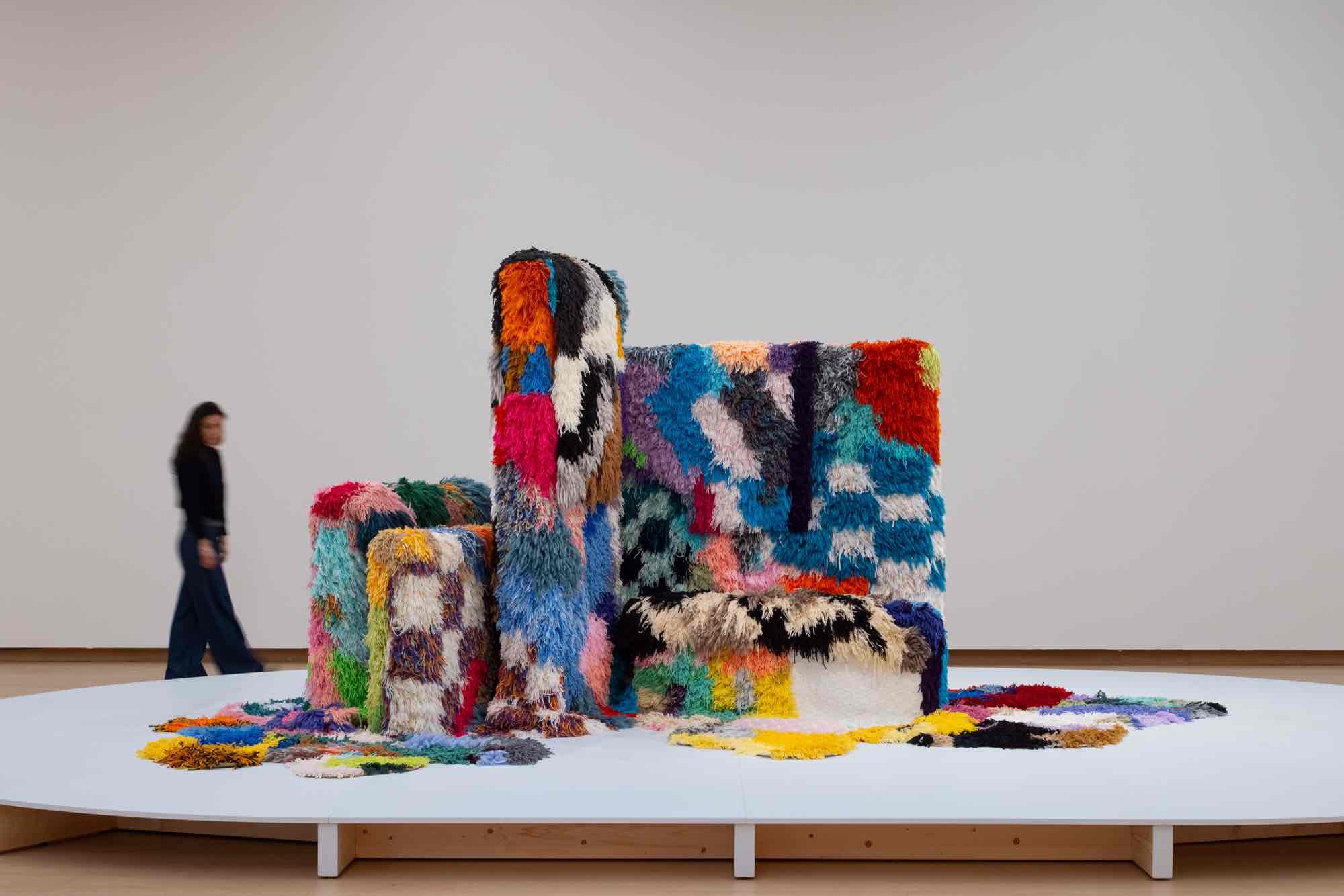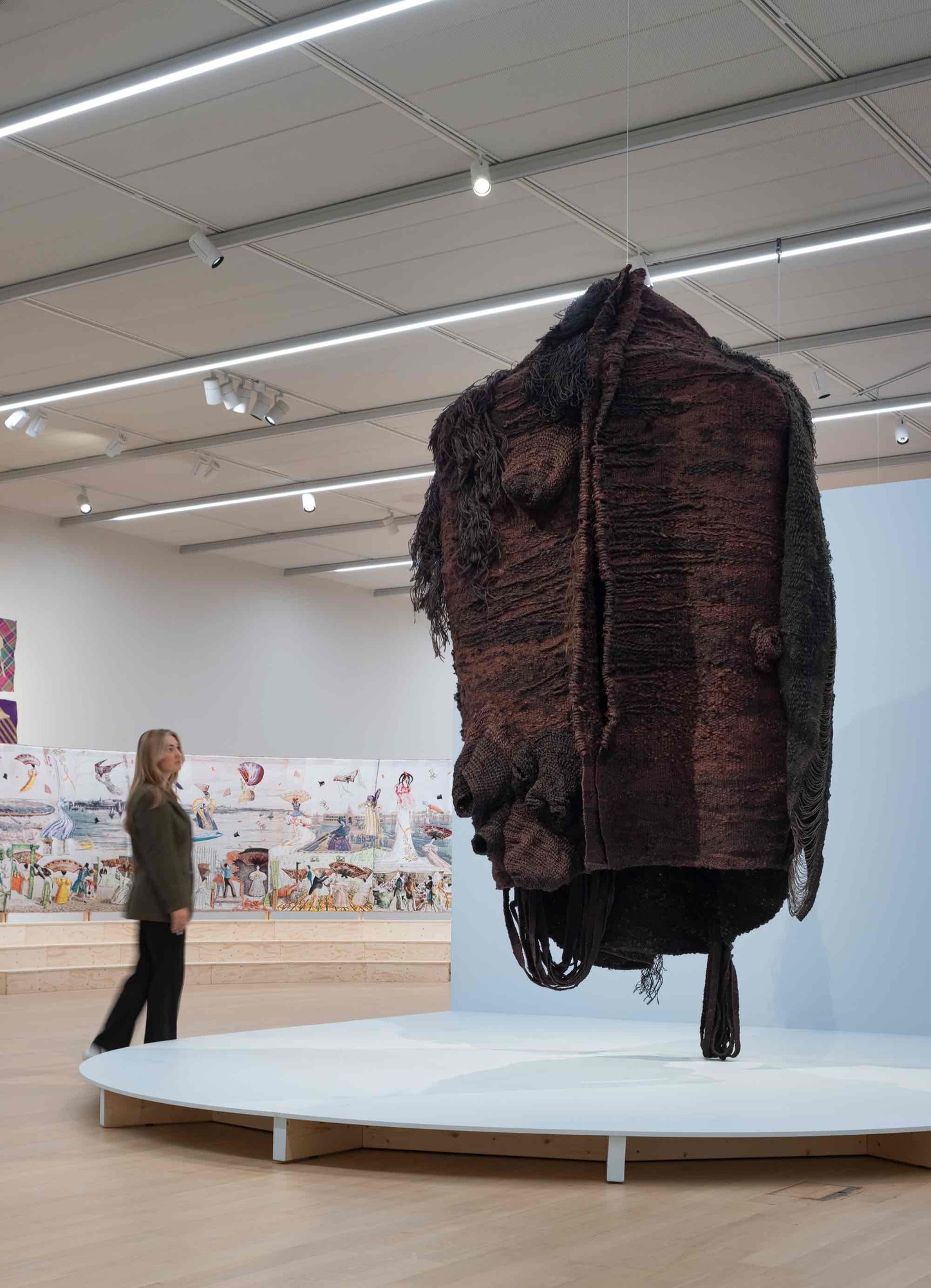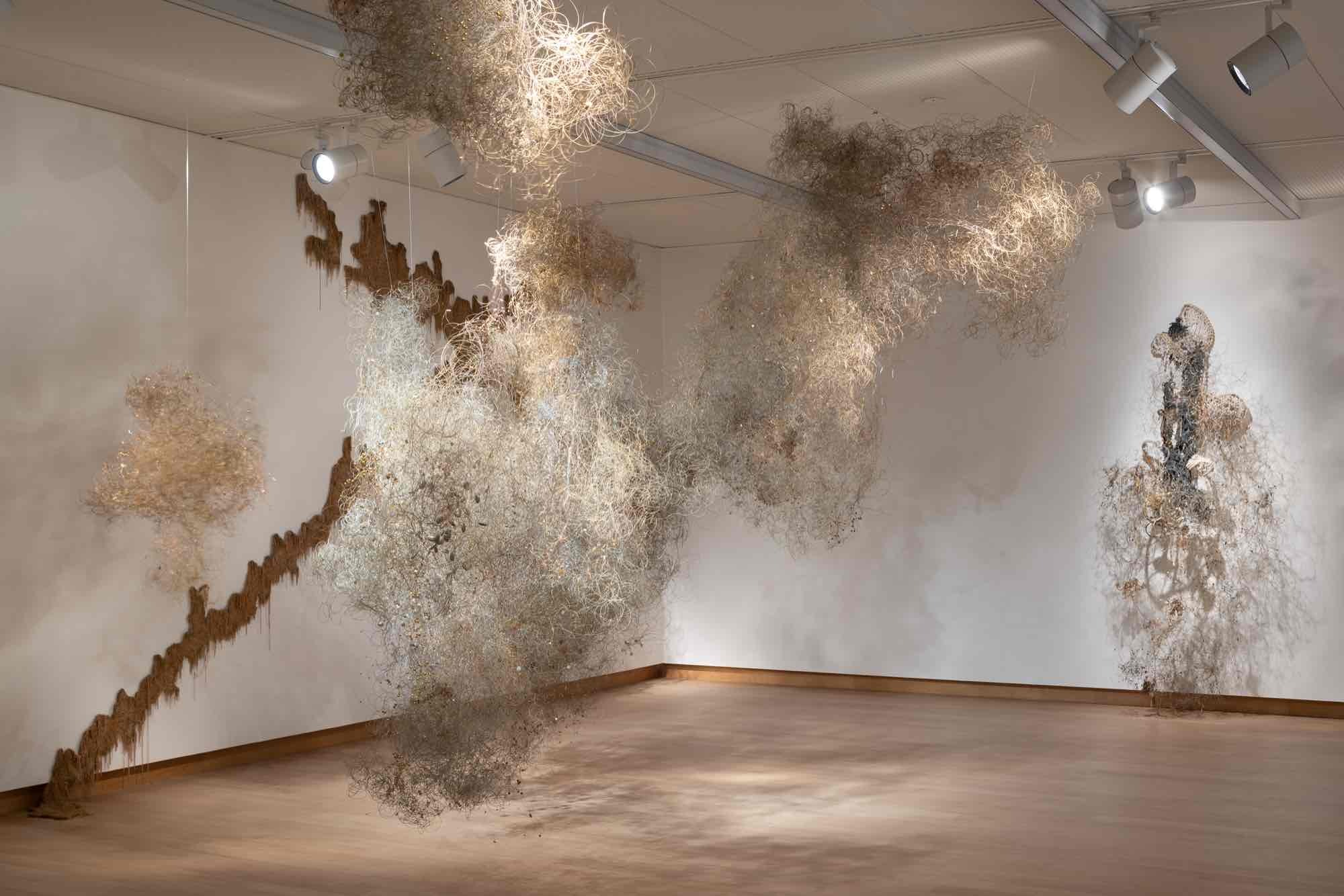Unravel
14 Sep 2024 - 05 Jan 2025

Cecilia Vicuña, Quipu Austral, 2012. Collection 49 Nord 6 Est - Frac Lorraine. In Unravel – The Power and Politics of Textiles in Art, Stedelijk Museum Amsterdam, 2024. Photo: Peter Tijhuis

Installation view Unravel – The Power and Politics of Textiles in Art, Stedelijk Museum Amsterdam, 2024. Photo: Peter Tijhuis

Installation view Unravel – The Power and Politics of Textiles in Art, Stedelijk Museum Amsterdam, 2024. Photo: Peter Tijhuis

Installation view Unravel – The Power and Politics of Textiles in Art, Stedelijk Museum Amsterdam, 2024. Photo: Peter Tijhuis

Sarah Zapata, To Teach or To Assume Authority, 2018-2019. Stedelijk Museum Amsterdam. Acquired with the generous support of the participants of the VriendenLoterij and Young Stedelijk, 2021. In Unravel – The Power and Politics of Textiles in Art, Stedelijk Museum Amsterdam, 2024. Photo: Peter Tijhuis

Tracey Emin, No chance (WHAT A YEAR), 1999. Private collection UK. Courtesy White Cube. © Tracey Emin, all rights reserved, DACS 2022. In Unravel - The Power and Politics of Textiles in Art, Stedelijk Museum Amsterdam, 2024. Photo: Peter Tijhuis.

Magdalena Abakanowicz, Vêtement noir (Black Garment), 1968. Stedelijk Museum Amsterdam. In Unravel - The Power and Politics of Textiels in Art, Stedelijk Museum Amsterdam, 2024. Photo: Peter Tijhuis.

Left: Diedrick Brackens, fire makes some dragons, 2020. The Hudgins Family. Right: Louise Bourgeois, Arch of Hysteria, 2000. Courtesy Galerie Karsten Greve, Cologne, Paris, St. Moritz. In Unravel – The Power and Politics of Textiles in Art, Stedelijk Museum Amsterdam, 2024. Photo: Peter Tijhuis

Igshaan Adams, installation Gebedswolke, 2021-2023 Courtesy of the artist and blank projects, Cape Town; Casey Kaplan, New York and Thomas Dane Gallery. In Unravel - The Power and Politics of Textiles in Art, Stedelijk Museum Amsterdam, 2024. Photo: Peter Tijhuis.
Few things are as present in our everyday lives as textiles. They cover and protect us, engage our senses, trigger our memories and represent our beliefs and tastes. Yet textiles remained underexamined in art history, while contemporary artists have rediscovered the powerful possibilities of textiles to tell their personal histories. In Unravel, the Stedelijk brings together 47 international contemporary artists, both renowned names like Louise Bourgeois, Tracey Emin and Sheila Hicks and many from younger generations from around the world.
The exhibition consists of approximately 100 works, 9 of which are from the Stedelijk collection, including recent acquisitions. Many of the international artists, like Jeffrey Gibson, who currently represents the US at the Venice Biennial, have not previously been shown in the Netherlands.
From intimate handmade pieces to large-scale sculptures: the colorful works in this group show are overwhelming and highlight impressive stories about power, resistance and survival, but also about resilience, love and hope. Artists with diverse, global perspectives share their personal histories, which are also current social and political stories.
The exhibition explores the role of textiles in art through six themes: ‘Subversive Stitch’, about, among other things, resistance to textiles as ‘women's work’, ‘Fabric of Everyday Life’, with personal stories and lived experiences, ‘Borderlands’, about physical and invisible borders, ‘Bearing Witness’, with textiles as social and sociopolitical commentary, ‘Wound and Repair’, textiles as a restorative and healing medium, and ‘Ancestral Threads’, about the lives and techniques of ancestors and alternative knowledge systems.
The exhibited works in Unravel are radical in both form and politics, and encompass a wide range of forms, scales, and techniques, drawing on historic methods of making as well as new and experimental processes.
Rein Wolfs, director of Stedelijk Museum Amsterdam: “The Stedelijk has a long history with textile art, it has been collected for the collection since 1930. One sees that from the 60s and 70s textiles become more sculptural and politically committed. At this moment, there is a revival, with many young makers using the medium to shape stories and with pioneers like Magdalena Abakanowicz being appreciated again. This exhibition shows that contemporary artists feel free to express themselves in every possible medium and that textiles add an extra dimension, both in terms of content and visual experience.”
Artists featured in the exhibition include:
Pacita Abad, Magdalena Abakanowicz, Igshaan Adams, Ghada Amer, Arpilleristas, Mercedes Azpilicueta, Kevin Beasley, Sanford Biggers, Louise Bourgeois, Diedrick Brackens, Jagoda Buić, Margarita Cabrera, Feliciano Centurión, Judy Chicago, Myrlande Constant, Cian Dayrit, Tracey Emin, Gee’s Bend/Lorraine Pettway, Jeffrey Gibson, Antonio Jose Guzman en Iva Jankovic, Harmony Hammond, Sheila Hicks, Nicholas Hlobo, Yee I-Lann, Kimsooja, Acaye Kerunen, José Leonilson, Tau Lewis, Ibrahim Mahama, Teresa Margolles, Georgina Maxim, Małgorzata Mirga-Tas, Violeta Parra, Antonio Pichillá Quiacaín, Faith Ringgold, LJ Roberts, Zamthingla Ruivah, Hannah Ryggen, Tschabalala Self, Mounira Al Solh, Angela Su, Lenore Tawney, T. Vinoja, Cecilia Vicuña, Billie Zangewa, and Sarah Zapata.
Curated by Amanda Pinatih (Stedelijk) and Lotte Johnson and Well Fray-Smith (Barbican).
The exhibition consists of approximately 100 works, 9 of which are from the Stedelijk collection, including recent acquisitions. Many of the international artists, like Jeffrey Gibson, who currently represents the US at the Venice Biennial, have not previously been shown in the Netherlands.
From intimate handmade pieces to large-scale sculptures: the colorful works in this group show are overwhelming and highlight impressive stories about power, resistance and survival, but also about resilience, love and hope. Artists with diverse, global perspectives share their personal histories, which are also current social and political stories.
The exhibition explores the role of textiles in art through six themes: ‘Subversive Stitch’, about, among other things, resistance to textiles as ‘women's work’, ‘Fabric of Everyday Life’, with personal stories and lived experiences, ‘Borderlands’, about physical and invisible borders, ‘Bearing Witness’, with textiles as social and sociopolitical commentary, ‘Wound and Repair’, textiles as a restorative and healing medium, and ‘Ancestral Threads’, about the lives and techniques of ancestors and alternative knowledge systems.
The exhibited works in Unravel are radical in both form and politics, and encompass a wide range of forms, scales, and techniques, drawing on historic methods of making as well as new and experimental processes.
Rein Wolfs, director of Stedelijk Museum Amsterdam: “The Stedelijk has a long history with textile art, it has been collected for the collection since 1930. One sees that from the 60s and 70s textiles become more sculptural and politically committed. At this moment, there is a revival, with many young makers using the medium to shape stories and with pioneers like Magdalena Abakanowicz being appreciated again. This exhibition shows that contemporary artists feel free to express themselves in every possible medium and that textiles add an extra dimension, both in terms of content and visual experience.”
Artists featured in the exhibition include:
Pacita Abad, Magdalena Abakanowicz, Igshaan Adams, Ghada Amer, Arpilleristas, Mercedes Azpilicueta, Kevin Beasley, Sanford Biggers, Louise Bourgeois, Diedrick Brackens, Jagoda Buić, Margarita Cabrera, Feliciano Centurión, Judy Chicago, Myrlande Constant, Cian Dayrit, Tracey Emin, Gee’s Bend/Lorraine Pettway, Jeffrey Gibson, Antonio Jose Guzman en Iva Jankovic, Harmony Hammond, Sheila Hicks, Nicholas Hlobo, Yee I-Lann, Kimsooja, Acaye Kerunen, José Leonilson, Tau Lewis, Ibrahim Mahama, Teresa Margolles, Georgina Maxim, Małgorzata Mirga-Tas, Violeta Parra, Antonio Pichillá Quiacaín, Faith Ringgold, LJ Roberts, Zamthingla Ruivah, Hannah Ryggen, Tschabalala Self, Mounira Al Solh, Angela Su, Lenore Tawney, T. Vinoja, Cecilia Vicuña, Billie Zangewa, and Sarah Zapata.
Curated by Amanda Pinatih (Stedelijk) and Lotte Johnson and Well Fray-Smith (Barbican).
